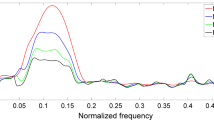Abstract
The strong noise produced by the leakage of electricity from marine seismic streamers is often received with seismic signals during marine seismic exploration. Traditional denoising methods show unsatisfactory effects when eliminating strong noise of this kind. Assuming that the strong noise signals have the same statistical properties, a blind source separation (BSS) algorithm is proposed in this paper that results in a new denoising algorithm based on the constrained multi-user kurtosis (MUK) optimization criterion. This method can separate strong noise that shares the same statistical properties as the seismic data records and then eliminate them. Theoretical and field data processing all show that the denoising algorithm, based on multi-user kurtosis optimization criterion, is valid for eliminating the strong noise which is produced by the leakage of electricity from the marine seismic streamer so as to preserve more effective signals and increase the signal-noise ratio. This method is feasible and widely applicable.
Similar content being viewed by others
References
Amari, S. I., Varinen, H. A., and Lee, S. Y., 2002, Blind signal separation and independent component analysis: Neurocomputing, 49, 1–5.
Canales, L. L, 1984, Random noise reduction: 54th Annual Internet. Mtg., Soc. Expl. Geophys., Expanded Abstracts, Session: S10.1, 525–572.
Cardoso, J. F., 1989, Source separation using higher order moments: in Proc IEEE Int Conf Acoust, Speech, Signal Process, 4, 2109–2112.
Comon, P., 1996, Contrasts for multichannel blind deconvolution: IEEE Signal Processing Lett, 3, 209–211.
Comon, P., 1994, Independent components analysis: A new concept: Signal Process, 36(3), 287–314.
Donoho, D., 1981, On minimum entropy deconvolution in applied time series analysis II: New York, Academic, 565–609.
Franco, R. D., and Musacchio, G., 2001, Polarization filter with singular value decomposition: Geophysics, 66(3), 932–938.
Galagher, N. C., and Wise, G. L., 1981, A theoretical analysis of the properties of Median Filters: IEEE Trans on Acoust, Speech and Signal Processing, 29(6), 1136–114.
Inouye, Y., 1998, Criteria for blind deconvolution of multichannel linear time invariant systems: IEEE Trans Signal Processing, Special Issue on Signal Processing for Advanced Communications, 45, 268–271.
Juttern, C., and Hearault, J., 1991, Blind separation of source, Part I: An adaptive algorithm based on neuromimetic architecture: Signal Processing, 24, 1–10.
Juttern, C., and Hearault, J., 1991, Blind separation of source, Part II: An adaptive algorithm based on neuromimetic architecture: Signal Processing, 24, 11–20.
Kamal, M., and AL-YAHYA, 1993, Application of partial karhunerr loeve transform to suppress random noise in seismic sections: Geophysical Prospecting, 39(1), 77–93.
Li, H. Y., Hao, R. F., Ma, J. F., and Wang, H. K., 2007, Separation of noisy mixed image based on wiener filtering and independent component analysis: Application Research of Computers, 24(10), 161–162, 165.
Mallat, S., 1989, Theory for multi-resolution signal decomposition: the wavelet representation: IEEE Transactions on Pattern Analysis and Machine Intelligence, 11(7), 674–693.
Papadias, C. B., 2000, Globally convergent blind source separation based on a multiuser kurtosis maximization criterion: IEEE Trans Signal Processing, 48(12), 3508–3519.
Papadias, C. B., and Paulraj, A., 1997, Blind separation of independent co-channel signals: 13th Int Conf Digital Signal Process, Santorini Greece, 139–142.
Papadias, C. B., and Paulraj, A., 1997, A constant modulus algorithm for multiuser signal separation in presence of delay spread using antenna arrays: IEEE Signal Processing Lett, 4, 178–181.
Shalvi, O., and Weinsten, E., 1990, New criteria for blind deconvolution of nonminimum phase systems (channels): IEEE Trans Inform Theory, 36, 312–321.
Shynk, J. J., and Gooch, R. P., 1996, The constant modulus array for cochannel signal copy and direction finding: IEEE Trans Signal Processing, 44, 652–660.
Swami, A. A., Giannakis, G., and Shamsunder, S., 1994, Multichannel ARMA processes: IEEE Trans, Signal Processing, 42, 898–913.
Touzni, A., and Fijalkow, I., 1997, Blind adaptive equalization and simultaneous separation of convolutive mixtures: Digital Signal Process, 391–394.
Treitel, S., 1974, The complex Wiener filter: Geophysics, 39, 169–173.
Tugnait, J. K., 1997, Blind spatiotemporal equalization and impulse response estimation for MIMO channel using a Godard cost function: IEEE Trans Signal Processing, Special Issue on Signal Processing for Advanced Communications, 45, 268–271.
Tugnait, J. K., 1997, Identification and deconvolution of multichannel linear non-Gaussian processes using higher order statistics and inverse filter criteria: IEEE Trans Signal Processing, 45, 658–672.
Van, D. V. A., and Paulraj, A., 1996, An analytical constant modulus algorithm: IEEE Trans Signal Processing, 44, 1136–1155.
Wei, L., 2004, Blind sources separation based on nonnegative matrix factorization: Electronics Optics & Control, 11(2), 38–41, 53.
Zhang, J. P., and Liu, A. L., 2008, Applications of blind source separation based on independent factor analysis: Journal of East China University of Science and Technology (Natural Science Edition), 34(3), 410–416.
Zhu, X. L., and Zhang, X. D., 2004, Overdetermined blind source separation based on singular value decomposition: Journal of Electronics and Information Technology, 26(3), 337–343.
Zong, T., Meng, H. Y., and Jia, Y. L., Liu, G. Z., 1998, Denoising method based on wavelet packet and forward-backward prediction in F-X domain: Chinese Journal of Geophysics, 41, 337–346.
Author information
Authors and Affiliations
Corresponding author
Additional information
This work is supported by the National Natural Science Foundation of China (No. 41176077) and the State Oceanic Administration Young Marine Science Foundation (No. 2013702).
Gao Wei received his Ph.D in Marine Geophysics at the Ocean University of China (2011). He is now a assistant researcher at the National Deep Sea Center, China. His research interests include blind deconvolution, blind signal separation, and seismic data processing methods of higher order statistics.
Liu Huai-Shan is professor and doctoral supervisor of the College of Marine Geo-science at the Ocean University of China. He is also the leader of Key Lab of Submarine Geosciences and Prospecting Techniques Ministry of Education. His research interests include high-resolution seismic data acquisition, processing and interpretation, comprehensive research of marine geology and geophysics.
Rights and permissions
About this article
Cite this article
Gao, W., Liu, HS. Strong noise attenuation method based on the multiuser kurtosis criterion. Appl. Geophys. 10, 25–32 (2013). https://doi.org/10.1007/s11770-013-0365-5
Received:
Revised:
Published:
Issue Date:
DOI: https://doi.org/10.1007/s11770-013-0365-5




